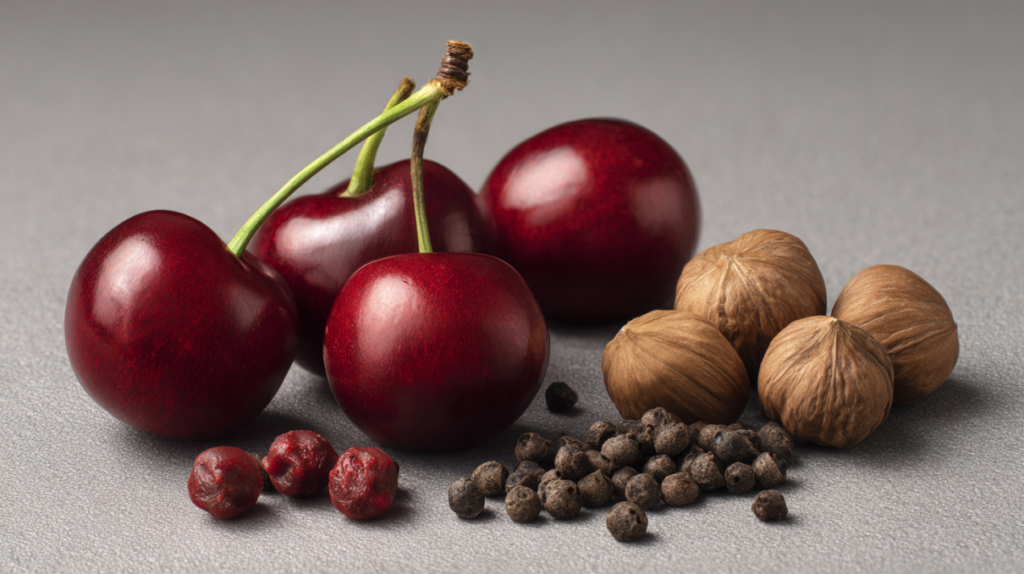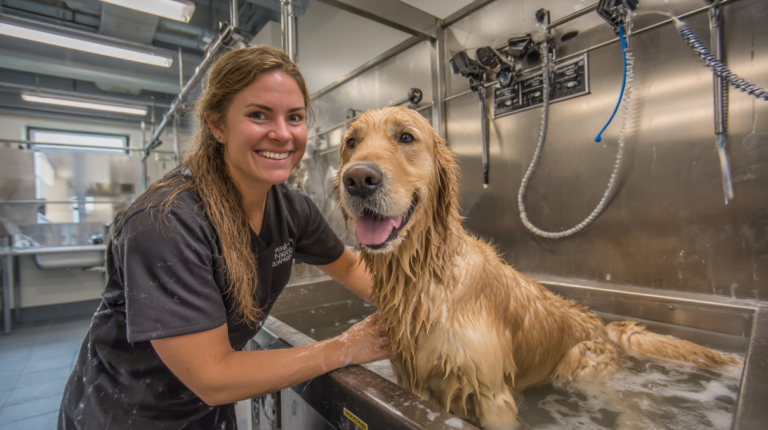Can dogs have cherries? Learn the 5 crucial facts about cherries and dogs, including safety risks, toxic parts, and safe alternatives for your pet’s health.
Table of Contents
Picture this: You’re enjoying a bowl of fresh, juicy cherries on a warm summer afternoon when your beloved dog gives you those irresistible puppy eyes, hoping for a taste. Before you share this sweet treat, you pause and wonder: can dogs have cherries? This seemingly simple question has a complex answer that every responsible pet owner should understand.
Can dogs have cherries? The short answer is that while the flesh of cherries isn’t toxic to dogs, the pits, stems, and leaves contain dangerous compounds that can be life-threatening. With over 68% of U.S. households owning pets and cherry consumption rising by 15% annually, understanding the relationship between dogs and cherries has never been more crucial for pet safety.
This comprehensive guide will explore everything you need to know about dogs and cherries, from the specific risks involved to safe alternatives that will keep your furry friend healthy and happy. Whether you’re a new pet owner or an experienced dog parent, these five important facts will help you make informed decisions about your dog’s diet and safety.
The Science Behind Cherries and Dogs: Understanding the Risks

When we ask “can dogs have cherries,” we need to understand what makes certain parts of this fruit dangerous for our canine companions. Cherries belong to the Prunus family, which includes peaches, plums, and apricots. The primary concern lies in a compound called amygdalin, found in the pits, stems, and leaves of cherry trees.
Amygdalin breaks down into hydrogen cyanide when digested, creating a toxic environment in your dog’s system. According to veterinary toxicologists, even small amounts of cyanide can cause serious health complications in dogs, especially smaller breeds who are more susceptible to poisoning due to their body weight.
The cherry flesh itself contains natural sugars and antioxidants that, in small quantities, aren’t harmful to dogs. However, the risk-benefit analysis clearly favors avoiding cherries altogether. Dr. Sarah Mitchell, a veterinary nutritionist at the American Animal Hospital Association, explains: “While the flesh of cherries isn’t inherently toxic, the risk of accidental pit ingestion and the high sugar content make cherries an unsuitable treat for dogs.”
Why Cherry Pits Are Particularly Dangerous
Cherry pits pose multiple threats to dogs beyond cyanide poisoning. These small, hard objects can cause:
Choking Hazards: Cherry pits are the perfect size to lodge in a dog’s throat or esophagus, creating an immediate emergency situation that requires veterinary intervention.
Intestinal Blockages: If swallowed, cherry pits can become trapped in the digestive tract, leading to severe complications that often require surgical removal.
Dental Damage: Dogs who attempt to chew cherry pits may crack or break their teeth, leading to painful dental procedures and potential infections.
The combination of these physical dangers with the chemical toxicity makes cherry pits one of the most dangerous fruit components for dogs.
Fact #1: Cherry Pits Contain Deadly Cyanide
The most critical fact about dogs and cherries involves the presence of cyanogenic glycosides in cherry pits. These compounds, primarily amygdalin, convert to hydrogen cyanide when broken down by digestive enzymes. This process, called enzymatic hydrolysis, occurs rapidly once the pit is chewed or crushed.
For more expert pet care tips and product recommendations, visit BlithePet.com — your trusted source for pet wellness.
Cyanide poisoning in dogs occurs when the chemical interferes with cellular respiration, preventing cells from utilizing oxygen effectively. This creates a domino effect throughout the body, affecting multiple organ systems simultaneously.
Symptoms of Cyanide Poisoning in Dogs
Recognizing the signs of cyanide poisoning can be life-saving. Symptoms typically appear within 15-30 minutes of ingestion and include:
Respiratory Distress: Difficulty breathing, rapid panting, or shallow breathing patterns indicate oxygen deprivation at the cellular level.
Bright Red Gums: Contrary to typical poisoning symptoms, cyanide causes gums to appear bright red due to the blood’s inability to release oxygen to tissues.
Weakness and Collapse: Dogs may become suddenly weak, stumble, or collapse as their body struggles to maintain normal functions.
Vomiting and Diarrhea: Gastrointestinal upset often accompanies cyanide poisoning, though these symptoms may be overshadowed by more severe respiratory issues.
Seizures: In severe cases, neurological symptoms including seizures may occur as the brain becomes oxygen-deprived.
The severity of symptoms depends on the dog’s size, the number of pits consumed, and how thoroughly the pits were chewed. Smaller dogs face higher risks due to their lower body weight and faster metabolism.
Fact #2: Not All Parts of Cherries Are Equally Dangerous
Understanding which parts of cherries pose the greatest risk helps pet owners make informed decisions about accidental exposure. While the question “can dogs have cherries” often receives a blanket “no” answer, the reality is more nuanced.
Cherry Flesh: The red, juicy part of the cherry contains minimal toxins but high sugar content. Small amounts of cherry flesh won’t poison your dog, but the sugar can contribute to obesity, dental problems, and digestive upset.
Cherry Pits: The most dangerous component, containing concentrated cyanogenic glycosides. Even one or two pits can cause problems in small dogs.
Stems and Leaves: Often overlooked, these parts also contain cyanogenic compounds and should be kept away from dogs.
Wild vs. Cultivated Cherries: Wild cherries, including black cherries and chokecherries, typically contain higher concentrations of toxic compounds than cultivated varieties.
The Sugar Content Concern
Even if we could eliminate the poisoning risk, cherries contain approximately 16 grams of sugar per cup. For dogs, this sugar load can cause immediate digestive upset and contribute to long-term health issues including:
- Obesity and weight gain
- Dental decay and gum disease
- Diabetes risk in predisposed dogs
- Gastrointestinal inflammation
Many pet owners don’t realize that dogs process sugars differently than humans. Their systems aren’t designed to handle large amounts of fructose, making high-sugar fruits like cherries problematic even without the toxicity concerns.
Fact #3: Size Matters – Small Dogs Face Greater Risks
The relationship between dog size and cherry toxicity cannot be overstated. When veterinarians assess “can dogs have cherries” cases, body weight is the primary factor in determining treatment protocols and prognosis.
Small Breeds (Under 25 pounds): Dogs like Chihuahuas, Yorkshire Terriers, and Pomeranians face the highest risk from cherry consumption. A single cherry pit can potentially cause serious symptoms in these tiny companions.
Medium Breeds (25-60 pounds): Breeds like Beagles, Cocker Spaniels, and Border Collies have more tolerance but can still experience significant problems from multiple pits or stems.
Large Breeds (Over 60 pounds): While German Shepherds, Golden Retrievers, and other large breeds have more tolerance, they’re not immune to cherry toxicity, especially if they consume multiple cherries with pits.
Case Study: Emergency Room Statistics
According to the Pet Emergency Network, cherry-related poisoning cases peak during summer months, with 78% of cases involving dogs under 30 pounds. Dr. Michael Rodriguez, an emergency veterinarian in California, reports: “We see at least two cherry poisoning cases each week during cherry season. The majority involve small dogs who found fallen cherries in yards or parks.”
One particularly concerning case involved a 4-pound Yorkie who consumed three cherry pits from a backyard tree. Despite immediate veterinary intervention, the dog required intensive care for 48 hours, highlighting how quickly small dogs can become critically ill from seemingly minor exposures.
Fact #4: Immediate Action Can Save Your Dog’s Life
Knowing what to do if your dog eats cherries can mean the difference between a full recovery and a tragic outcome. The timeframe for effective intervention is narrow – typically 30-60 minutes from ingestion to the onset of serious symptoms.
Emergency Response Steps
Step 1: Assess the Situation
- Determine how many cherries were consumed
- Check if pits were likely swallowed
- Note the time of ingestion
- Observe your dog for immediate symptoms
Step 2: Contact Your Veterinarian
- Call your regular vet or emergency clinic immediately
- Provide specific details about the ingestion
- Follow their guidance exactly
- Prepare for potential emergency transport
Step 3: Do NOT Induce Vomiting
- Unlike some poisoning cases, inducing vomiting with cherry pits can cause additional choking risks
- Wait for professional medical guidance
- Keep your dog calm and comfortable
Step 4: Monitor Vital Signs
- Watch breathing patterns
- Check gum color
- Note any changes in behavior or mobility
- Document symptoms for veterinary staff
What NOT to Do
Common mistakes pet owners make during cherry poisoning emergencies include:
- Giving milk or food, thinking it will “absorb” the toxins
- Using home remedies or internet advice
- Waiting to see if symptoms develop
- Attempting to remove pits from the dog’s mouth if they’re actively swallowing
Fact #5: Prevention Is Better Than Treatment
The most effective approach to the question “can dogs have cherries” is complete avoidance. Prevention strategies protect your dog from accidental exposure while ensuring peace of mind for pet owners.
Home Safety Measures
Garden Management: If you have cherry trees on your property, regularly clean up fallen fruit. Install barriers or fencing to prevent access to areas where cherries might fall.
Storage Protocols: Keep fresh cherries in sealed containers or refrigerator drawers that dogs cannot access. Dispose of pits immediately in secure trash containers.
Family Education: Ensure all family members, including children, understand that cherries are off-limits for dogs. Create clear rules about sharing human food with pets.
Training and Behavioral Prevention
Teaching your dog reliable “leave it” and “drop it” commands can prevent cherry consumption during walks or outdoor activities. These commands should be practiced regularly and reinforced with positive training methods.
Many professional dog trainers recommend using high-value treats during training sessions to ensure your dog will respond even when faced with tempting foods like cherries.
Safe Alternatives: Healthy Treats Your Dog Will Love
Rather than risking your dog’s health with cherries, consider these safe, dog-friendly alternatives that provide similar nutritional benefits without the dangers:
Antioxidant-Rich Options
Blueberries: Often called a “superfood” for dogs, blueberries provide antioxidants, fiber, and vitamins without toxic compounds. They’re small enough for easy consumption and low in sugar compared to cherries.
Blackberries: These berries offer vitamin C and fiber while being safe for dogs in moderation. Their natural sweetness satisfies dogs’ occasional desire for fruity treats.
Cranberries: Unsweetened, fresh cranberries support urinary tract health and provide antioxidants. Avoid dried cranberries, which often contain added sugars.
Other Healthy Fruit Options
Apple Slices: Remove seeds and core, but apple flesh provides vitamins and fiber. The crunchy texture also helps clean teeth naturally.
Watermelon: This hydrating fruit is perfect for summer treats. Remove seeds and rind, but the flesh is safe and refreshing for dogs.
Bananas: High in potassium and natural sugars, bananas make excellent training treats when cut into small pieces.
Common Myths About Dogs and Cherries Debunked
Misinformation about dogs and cherries circulates frequently among pet owners. Let’s address the most common myths with scientific facts:
Myth 1: “A Few Cherries Won’t Hurt”
Reality: Even one cherry pit can cause problems in small dogs. The concentration of cyanogenic glycosides varies between individual cherries, making it impossible to predict safe quantities.
Myth 2: “Cooking Cherries Makes Them Safe”
Reality: While cooking may reduce some toxins, it doesn’t eliminate them entirely. Cooked cherries also concentrate sugars, creating different health risks for dogs.
Myth 3: “Large Dogs Can Handle Cherry Pits”
Reality: While large dogs have more tolerance, they’re not immune to cyanide poisoning. Multiple pits or individual sensitivity can still cause serious problems.
When to Consult Your Veterinarian
Understanding when professional veterinary care is necessary helps ensure your dog receives appropriate treatment. Contact your veterinarian immediately if:
- Your dog has consumed any amount of cherries with pits
- Symptoms of distress appear after cherry consumption
- You’re unsure about the quantity consumed
- Your dog has underlying health conditions that might increase sensitivity
Building a Relationship with Your Veterinary Team
Regular check-ups and open communication with your veterinarian create a foundation for emergency situations. Many veterinary practices offer 24-hour emergency contact services for established clients, providing peace of mind during off-hours emergencies.
Discussing your dog’s diet and potential hazards during routine visits helps your veterinarian understand your pet’s specific needs and risk factors.
Expert Tips for Pet-Safe Summer Fruit Enjoyment
Summer brings abundant fresh fruit, but pet owners need strategies to enjoy these treats safely around their dogs:
Tip 1: Create Designated Eating Areas
Establish specific areas where humans consume potentially dangerous foods like cherries. This prevents accidental dropping and reduces your dog’s access to harmful items.
Tip 2: Implement the “Two-Bowl System”
When enjoying fruit outdoors, use one bowl for fresh fruit and another for pits and stems. This organization prevents confusion and ensures proper disposal of dangerous components.
Tip 3: Teach Children About Pet Safety
Children often share food with pets without understanding the risks. Regular education about which foods are safe for dogs helps prevent accidental poisoning incidents.
Tip 4: Plan Pet-Friendly Alternatives
When serving cherries to humans, prepare dog-safe treats simultaneously. This prevents feelings of exclusion and reduces begging behavior.
Tip 5: Master the Art of Distraction
High-value training treats can redirect your dog’s attention when you’re eating cherries or other potentially dangerous foods.
The Role of Seasonal Awareness in Pet Safety
Cherry season typically runs from late spring through early summer, varying by geographic location and cherry variety. Pet owners should heighten awareness during these months, particularly when:
- Visiting areas with wild cherry trees
- Attending outdoor events where cherries might be served
- Walking dogs through neighborhoods with cherry trees
- Gardening or yard work in areas where cherries might fall
Geographic Considerations
Different regions have varying cherry seasons and wild cherry populations. Pacific Northwest residents face different risks than those in the Northeast or Southeast. Understanding your local environment helps you prepare appropriate prevention strategies.
Creating a Pet Emergency Kit
Every pet owner should maintain an emergency kit that includes:
- Contact information for regular and emergency veterinarians
- Pet poison control hotline numbers
- Basic first aid supplies
- Current photos of your dog
- Medical history and medication lists
- Transportation carrier appropriate for your dog’s size
Having these materials readily available reduces response time during emergencies and ensures you can provide accurate information to veterinary professionals.
Educational Table:
Markdown Version:
| Cherry Component | Toxicity Level | Risk to Small Dogs | Risk to Large Dogs | Symptoms | Emergency Action |
|---|---|---|---|---|---|
| Cherry Flesh | Low | Digestive upset | Digestive upset | Mild stomach issues | Monitor closely |
| Cherry Pits | Very High | Life-threatening | Serious concern | Breathing problems, weakness, red gums | Immediate vet care |
| Stems & Leaves | High | Dangerous | Moderate concern | Similar to pit symptoms | Veterinary consultation |
| Wild Cherry Varieties | Extremely High | Critical emergency | Life-threatening | Rapid onset symptoms | Emergency vet immediately |
| Maraschino Cherries | Moderate | Sugar toxicity risk | Mild concern | Vomiting, diarrhea | Monitor and limit water |
FAQ Section :
Q: Can dogs eat cherries without the pits?
A: While cherry flesh isn’t toxic, it’s still not recommended due to high sugar content and the risk of accidental pit consumption. The sugar can cause digestive upset and contribute to obesity and dental problems in dogs.
Q: What should I do if my dog ate a cherry pit?
A: Contact your veterinarian immediately. Do not induce vomiting as this can cause choking. Monitor your dog for symptoms like difficulty breathing, weakness, or bright red gums, and seek emergency veterinary care if any symptoms appear.
Q: Are maraschino cherries safe for dogs?
A: No, maraschino cherries are not safe for dogs. They contain high amounts of sugar and artificial additives that can cause digestive upset and other health problems. The preservatives and dyes can also be harmful to dogs.
Q: How many cherry pits are dangerous for dogs?
A: Even one cherry pit can be dangerous, especially for small dogs. The toxicity depends on the dog’s size, weight, and individual sensitivity. It’s best to treat any cherry pit consumption as a potential emergency.
Q: Can dogs have cherry juice or cherry-flavored products?
A: No, dogs should not have cherry juice or cherry-flavored products. These items often contain concentrated sugars, artificial flavors, and sometimes real cherry extract that can be harmful to dogs.
Q: What are the signs of cherry poisoning in dogs?
A: Signs include difficulty breathing, bright red gums, weakness, vomiting, diarrhea, and in severe cases, collapse or seizures. Symptoms typically appear within 15-30 minutes of ingestion and require immediate veterinary attention.
Q: Are there any safe cherry alternatives for dogs?
A: Yes! Blueberries, blackberries, apple slices (without seeds), and small pieces of watermelon are safe alternatives that provide similar antioxidants and natural sweetness without the risks associated with cherries.
Conclusion:
The question can dogs have cherries has a clear answer: the risks far outweigh any potential benefits. While the flesh of cherries isn’t inherently toxic, the presence of dangerous pits, stems, and leaves makes cherries an unsuitable treat for dogs of any size.
The five important facts we’ve explored – the cyanide content in pits, the varying danger levels of different cherry parts, the increased risk for small dogs, the importance of immediate emergency response, and the value of prevention – provide a comprehensive framework for keeping your dog safe during cherry season and beyond.
Remember that prevention is always more effective than treatment. By choosing safe alternatives like blueberries, apples, and other dog-friendly fruits, you can provide your pet with healthy treats without compromising their safety. The investment in pet-safe foods and prevention strategies protects both your dog’s health and your peace of mind.
As responsible pet owners, our goal is to provide our dogs with the best possible care while ensuring their safety and happiness. Understanding the risks associated with cherries is just one part of comprehensive pet care that includes proper nutrition, regular veterinary checkups, and ongoing education about potential hazards.
Have a similar experience with your pet? Share it in the comments below! Don’t forget to check out our other helpful guides at BlithePet.com for more expert advice on keeping your furry family members healthy and happy.







